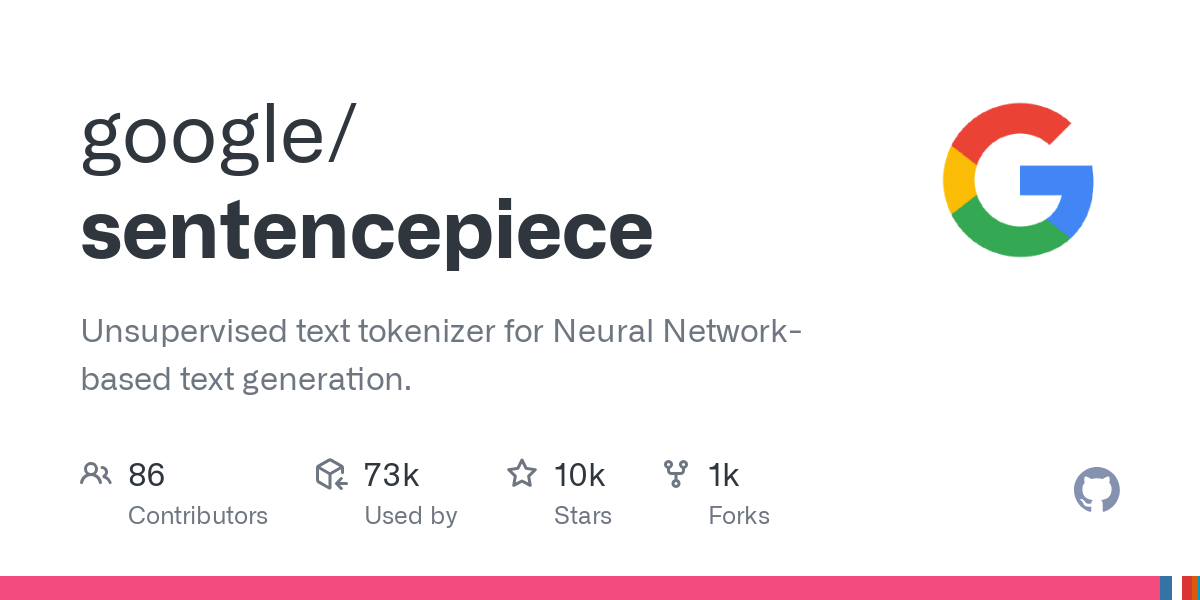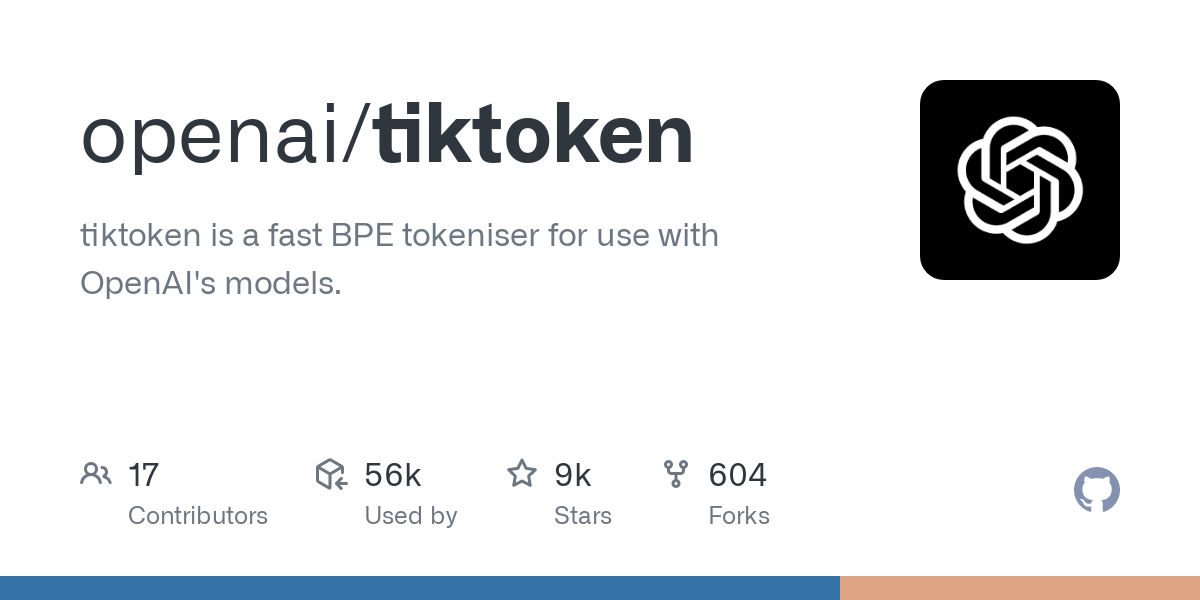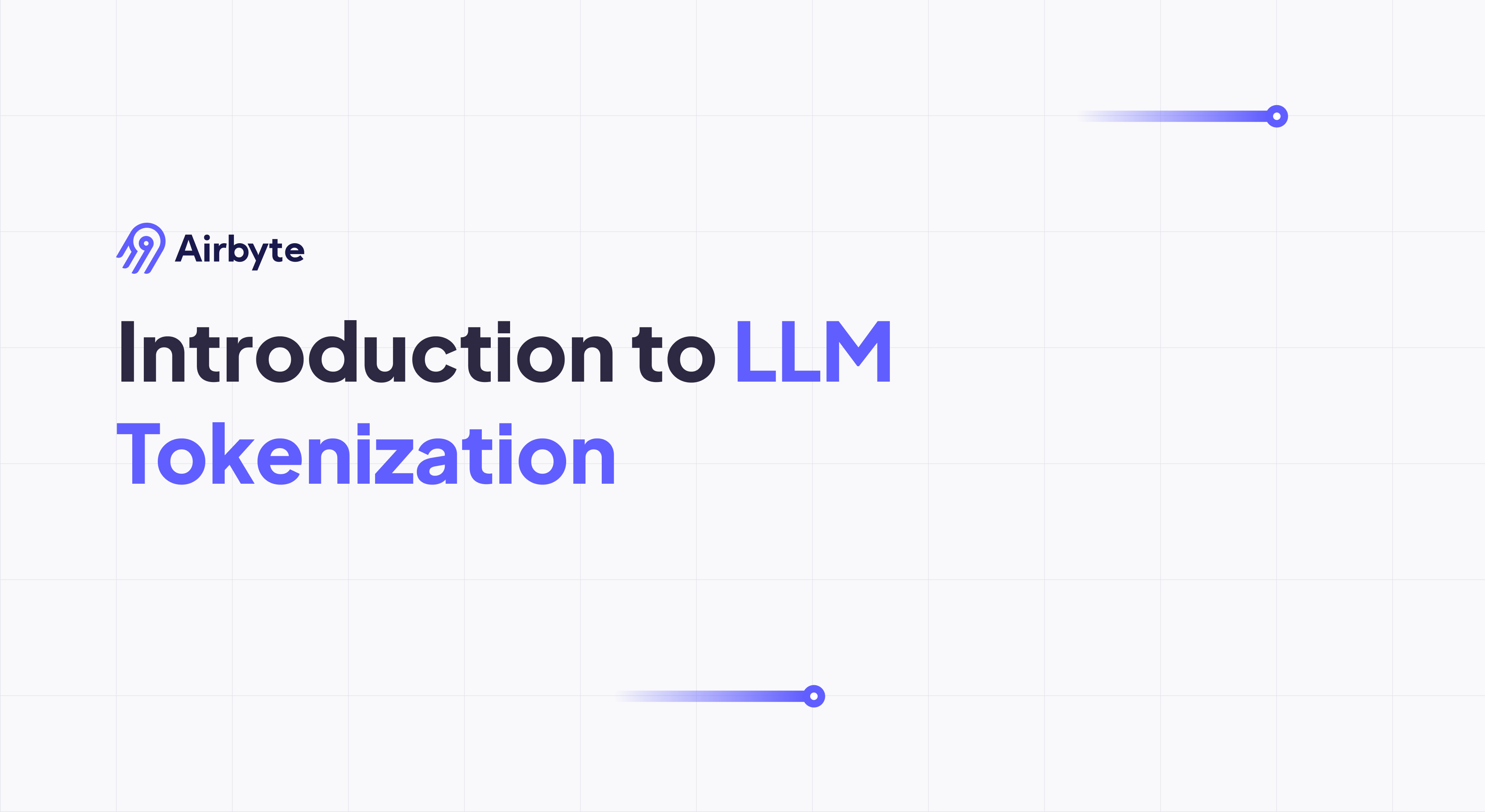Introduction to LLM Tokenization
Summarize this article with:
✨ AI Generated Summary
Tokenization is crucial for LLM performance, affecting vocabulary size, processing efficiency, and fairness across languages. Modern methods include adaptive, dynamic, and tokenizer-free approaches that improve multilingual support, domain adaptation, and security. Popular libraries like Hugging Face, SentencePiece, and OpenAI Tiktoken offer optimized tokenization, while tools like Airbyte facilitate comprehensive data integration for effective model training.
- Tokenization impacts model accuracy, speed, and cost by determining token sequences and vocabulary.
- Adaptive and dynamic tokenization adjust to domain-specific needs without costly retraining.
- Tokenizer-free methods process raw bytes or character triplets, enhancing multilingual and sovereign AI applications.
- Security and fairness require transparency and auditing to prevent adversarial attacks and bias.
- Efficient tokenization balances vocabulary size and token length, optimizing computational resources.
Tokenization serves as the foundation for how large language models understand and process human language. While early approaches relied on simple word splitting, modern LLM tokens have evolved into sophisticated systems that determine model performance, efficiency, and fairness across diverse applications.
This comprehensive guide explores both traditional and cutting-edge tokenization methods, helping you understand how these techniques shape model behavior and performance. Whether you're building multilingual applications or optimizing for specific domains, mastering tokenization principles enables you to make informed decisions about model architecture and data preparation strategies.
What Is LLM-Based Tokenization?
LLMs are usually trained on sequences of elements called tokens represented in vector form rather than just sentences.
Tokenization in LLMs is the process of separating a sequence of words into discrete components that form part of an LLM's vocabulary. These LLM tokens may include words, letters, or sequences of letters that enable models to process and understand human language systematically.
For example, consider the line from the poem:
Humpty Dumpty sat on a ____.
Humans easily understand the meaning of this sentence and can guess the missing word. Machines, however, first view this sentence as a series of characters or tokens.
To predict the next word, a machine needs to tokenize the sentence and identify whether it's a word or a letter that fills the blank space. This can be efficiently achieved using Python's Natural Language Toolkit (NLTK) for natural-language processing (NLP).
Each element in this list is a token mapped to a unique ID in the model's vocabulary. For instance, the OpenAI tokenizer converts the sentence into a list of IDs:
Note that the sequence pty appears twice, which is why the ID 1625 is repeated.
Why Does Tokenization Matter for LLM Performance?
Tokenization significantly impacts an LLM's behavior because it determines the model's vocabulary and processing efficiency. Most issues encountered with LLMs can be traced back to how the text is tokenized.
Raw text may lead to spelling errors or mishandling of multiple languages. The right tokenization techniques help manage these issues and yield more accurate responses while optimizing computational resources.
Modern tokenization approaches address several critical challenges that affect model performance. Over-fragmentation in subword tokenization can create unnecessarily long token sequences, particularly problematic for morphologically rich languages like German or Turkish. Additionally, traditional tokenizers trained on limited datasets struggle with domain-specific jargon or low-resource languages, requiring costly model retraining.
Security considerations also play a crucial role, as tokenization vulnerabilities can enable adversarial attacks that bypass safety filters by manipulating token sequences. Recent research has identified attack methods that exploit tokenization patterns to force models into incorrect or harmful responses.
How Do LLM Tokens Relate to Model Vocabulary?
Vocabulary determines both the data on which the model is trained and the output it produces. Tokenization expands that vocabulary by introducing new tokens with unique IDs. As a result, the model recognizes and responds to new phrases, improving output quality.
The relationship between tokenization and vocabulary extends beyond simple word recognition. Modern approaches consider semantic relationships between tokens, enabling models to understand morphological variations and cross-lingual similarities. This becomes particularly important when dealing with compound words or agglutinative languages where traditional word-level tokenization fails.
When aligning your LLM with business-specific needs, it's vital to train on relevant in-house and cloud data even if it's distributed across sources. Tools such as Airbyte can consolidate data into a single destination for easier model training, ensuring comprehensive vocabulary coverage across diverse data sources.
Token alignment also affects model efficiency. Well-designed tokenization reduces the number of tokens needed to represent the same information, directly impacting computational costs and inference speed. This becomes critical for applications requiring real-time responses or processing large document collections.
What Is the Real-Time Tokenization Process?
Real-time tokenization instantly converts text into tokens so LLMs can produce prompt, accurate responses. The process involves several sophisticated steps that balance speed with accuracy.
The system breaks incoming text into tokens from the LLM's vocabulary, assigns each token a unique ID, and optionally prepends or appends special tokens to enhance model understanding. Modern implementations optimize this process through parallel processing and caching mechanisms.
Advanced real-time systems employ dynamic tokenization strategies that adapt to context and domain-specific requirements. These systems can modify tokenization rules based on the input type, whether processing code, natural language, or structured data formats.
What Are Popular Tokenization Libraries and Models?
1. Hugging Face Tokenizer

A widely used, production-ready library. With its Rust implementation, it can tokenize ~1 GB of data in < 20 seconds on CPU, supporting alignment tracking from original text to tokens.
The library provides extensive customization options for different model architectures and supports both training and inference workflows. Its modular design allows developers to implement custom tokenization strategies while leveraging optimized core functionality.
2. SentencePiece

An unsupervised tokenizer that uses a unigram language model and subword units (e.g., BPE). It can be trained directly on raw sentences without pre-tokenization.
SentencePiece excels in multilingual scenarios by handling complex scripts and eliminating language-specific preprocessing requirements. Its approach to processing raw Unicode text makes it particularly effective for languages without clear word boundaries.
3. OpenAI Tiktoken

Open-source tokenizer from OpenAI. Common encoding schemes include cl100k_base, p50k_base, and r50k_base, each defining how text splits into tokens, treats spaces, and handles non-English characters.
Tiktoken optimizes for speed and consistency across OpenAI's model family. Its design prioritizes deterministic tokenization results, ensuring reproducible outputs across different execution environments.
4. NLTK Tokenize
In Python, NLTK provides multiple tokenization methods (e.g., word_tokenize, sent_tokenize). Ensure you pass Unicode text rather than encoded byte strings.
NLTK offers rule-based tokenization approaches that work well for traditional NLP tasks and provide transparent, interpretable tokenization decisions. While not optimized for large-scale LLM applications, it remains valuable for prototyping and educational purposes.
What Are Adaptive and Dynamic Tokenization Methods?
Modern LLM development has introduced adaptive tokenization methods that synchronize tokenizer performance with model training dynamics. These approaches move beyond static tokenization rules to create systems that evolve alongside model capabilities.
Adaptive tokenizers iteratively refine tokenization strategies based on real-time assessments of model performance metrics such as perplexity. This method begins with a broad initial vocabulary and dynamically adjusts token boundaries during training to maximize alignment with the model's evolving language patterns. Research demonstrates that adaptive tokenizers achieve improvements in perplexity compared to static methods without increasing vocabulary size.
Dynamic Vocabulary Expansion
Dynamic tokenization enables runtime vocabulary adaptation through techniques like the zip2zip framework, which applies compression principles to merge token sequences during inference. This approach creates hypertokens for repeated or domain-specific patterns, reducing token sequence length while maintaining semantic meaning.
The framework generates embeddings for novel tokens on the fly, bypassing traditional embedding layer constraints. This capability proves particularly valuable for specialized domains where static vocabularies struggle with technical terminology or evolving language patterns.
Domain-Specific Optimization
Adaptive tokenization addresses the challenge of transferring models to specialized domains without expensive retraining. Recent developments show that adjusting tokenizers to match domain-specific corpora achieves significant performance gains compared to full domain-specific pretraining while reducing computational costs and training time.
These methods prove especially effective for enterprises requiring LLM customization for legal documents, medical reports, or technical manuals. Organizations can now adopt tokens optimized for industry-specific terminology without overhauling entire model architectures.
How Do Tokenizer-Free Approaches Revolutionize LLM Architecture?
Recent innovations in LLM architecture have introduced tokenizer-free approaches that eliminate traditional tokenization steps entirely. These methods address fundamental limitations of subword tokenization while improving efficiency and multilingual support.
Byte-Level Processing
ByT5 represents a breakthrough approach that processes raw UTF-8 bytes directly, using a minimal vocabulary of 256 byte values plus control tokens. This method provides universal coverage for any text input while eliminating out-of-vocabulary token issues that plague traditional approaches.
Byte-level processing excels particularly for low-resource languages and technical documentation where character-level precision matters. The approach scales multilingually by avoiding language-specific rules, but eliminating tokenization steps during inference does not reduce latency—in fact, it often increases it due to longer input sequences.
Character Triplet Embeddings
T-Free frameworks abandon subword tokens entirely, instead mapping words to sparse activation patterns over character triplets. Each character triplet receives a unique index via hash functions, enabling words to be represented as sets of active triplets.
This approach achieves competitive performance with significantly fewer embedding parameters compared to subword tokenizers. The method demonstrates particular strength in cross-lingual transfer, outperforming standard tokenizers when adapting to unseen languages through the exploitation of morphological similarities.
Sovereign AI Applications
Tokenizer-free architectures enable better fine-tuning for industry-specific applications and low-resource languages. These innovations support sovereign AI solutions where organizations require complete control over model behavior without dependence on pre-trained tokenization vocabularies.
The approach proves particularly valuable for government and enterprise applications requiring data sovereignty, enabling secure deployments of customized LLMs without relying on external tokenization dependencies.
How Does Tokenization Impact Model Performance?
Tokenization choices directly affect LLM speed, accuracy, and fairness across languages.
Performance Factors
1. Algorithm Selection
Different algorithms—BPE, Unigram, WordPiece, SentencePiece—handle text differently. Research shows SentencePiece performs best for multilingual models, offering better accuracy and lower latency.
2. Vocabulary Size
Larger vocabularies improve accuracy but increase computational costs:
English models: ~33,000 tokens (medium-sized applications)
Multilingual models: 3x larger vocabularies needed for 5+ languages
Optimal size depends on model scale and available resources
3. Tokenizer Library
Choose based on your requirements: processing speed, latency constraints, and accuracy needs.
Multilingual Considerations
1. English Bias Problem
English-centric tokenizers create performance gaps:
Non-English text gets over-segmented (e.g., 130 tokens in English vs. 200+ in German for the same content)
Increased latency for non-English languages
Unequal processing efficiency across languages
2. Modern Solutions
Advanced tokenizers address these issues through:
Morphological awareness: Automatically identifying shared roots and suffixes across languages
Cross-lingual alignment: Balancing token distribution to ensure equitable performance for all supported languages
What Are the Best Practices for Efficient Tokenization?
Effective tokenization requires strategic consideration of multiple factors that influence both model performance and operational efficiency. Modern best practices extend beyond simple algorithm selection to encompass security, fairness, and computational optimization.
Select a tokenization library that matches your workflow and integrates seamlessly with your system architecture. Consider factors such as processing speed, memory usage, and compatibility with your deployment environment. Choose an algorithm (BPE, Unigram, WordPiece, SentencePiece) that suits your specific data characteristics and use case requirements.
Balance vocabulary size carefully, as larger vocabularies can boost accuracy but increase computational overhead. Consider the trade-offs between token sequence length and vocabulary size, particularly for resource-constrained environments or real-time applications.
Security and Ethical Considerations
Implement tokenization transparency measures to prevent potential overcharging in pay-per-token pricing models. Audit token sequences alongside outputs to verify alignment and detect potential manipulation of token counts by service providers.
Consider fairness implications of tokenization choices, particularly for multilingual applications. Evaluate tokenization performance across different languages and demographic groups to ensure equitable model behavior.
Performance Optimization
Implement caching strategies for frequently tokenized content to reduce computational overhead. Consider parallel processing approaches for batch tokenization workloads, and optimize token sequence lengths to balance accuracy with efficiency.
Monitor tokenization performance metrics regularly, including token-to-character ratios, processing speed, and downstream model performance. Adjust tokenization strategies based on empirical results rather than theoretical considerations alone.
How Can Airbyte Support LLM Training and Tokenization Workflows?
Modern LLM development requires comprehensive data integration capabilities to prepare diverse training datasets effectively. Airbyte's platform addresses critical challenges in collecting, consolidating, and preparing data for tokenization and model training workflows.
Comprehensive Data Collection
Airbyte's extensive connector library enables organizations to gather training data from diverse sources, including databases, APIs, files, and SaaS applications. This comprehensive data collection capability ensures tokenization vocabularies reflect the full spectrum of language use across business domains.
The platform's support for both structured records and unstructured files in synchronized pipelines preserves metadata and data relationships crucial for effective tokenization. This approach provides LLMs with richer context by maintaining connections between different data types throughout the processing pipeline.
Scalable Processing Infrastructure
Airbyte's cloud-native architecture automatically scales with data processing demands, handling the large-scale data movement required for LLM training. The platform processes substantial data volumes daily across customer deployments, providing the reliability and performance needed for production tokenization workflows.
Direct loading capabilities reduce computational overhead by eliminating intermediate storage steps, accelerating the data preparation process for tokenization and training. This efficiency proves particularly valuable when preparing large multilingual datasets or domain-specific corpora.
Multi-Region Data Sovereignty
For organizations developing sovereign AI solutions or operating under strict data residency requirements, Airbyte's multi-region deployment capabilities ensure training data remains within specified geographic boundaries. This capability supports the development of region-specific tokenization vocabularies while maintaining centralized pipeline management.
The platform's separation of control planes and data planes enables hybrid environments where sensitive training data stays local while benefiting from centralized orchestration and monitoring capabilities.
Conclusion
Tokenization serves as the foundation for effective LLM development, with modern approaches extending far beyond traditional word splitting to encompass adaptive, dynamic, and context-aware methods. Understanding these techniques enables informed decisions about model architecture, training data preparation, and deployment strategies.
The evolution from static tokenization to adaptive and tokenizer-free approaches represents a fundamental shift toward more efficient, fair, and capable language processing systems. These innovations address critical challenges in multilingual support, computational efficiency, and domain adaptation while opening new possibilities for specialized applications.
By choosing appropriate tokenization strategies, optimizing vocabulary design, and implementing best practices for security and fairness, organizations can significantly improve model performance and reliability while reducing operational costs and complexity.
Frequently Asked Questions
1. What is the difference between tokens and words in LLM processing?
In LLMs, tokens are the basic processing units—words, subwords, or characters—whereas words are just human-readable text. A word may split into multiple tokens, or several words form one token, depending on how the model’s tokenizer works.
2. How does tokenization affect LLM costs and pricing?
Most LLM providers charge based on token count rather than character or word count. Efficient tokenization can significantly reduce costs by creating shorter token sequences for the same content. Different tokenization methods can produce varying token counts for identical text, directly impacting usage charges in pay-per-token pricing models.
3. Can tokenization be customized for specific domains or languages?
Yes, tokenization can be adapted for specific domains through vocabulary customization and adaptive methods. Organizations can train domain-specific tokenizers that better handle technical terminology, specialized jargon, or specific languages. Modern approaches enable this customization without requiring complete model retraining.
4. What are the security implications of tokenization in LLMs?
Tokenization can create security vulnerabilities through adversarial attacks that manipulate token sequences to bypass safety filters. Additionally, pay-per-token pricing models create potential transparency issues where users cannot verify actual token usage. Implementing proper auditing and transparency measures helps mitigate these risks.
5. How do multilingual models handle tokenization challenges?
Multilingual models use specialized tokenization approaches like SentencePiece or universal tokenizers that handle diverse scripts and languages more equitably. These methods reduce bias toward specific languages and improve performance across different linguistic families, though they typically require larger vocabularies than monolingual approaches.

.webp)
